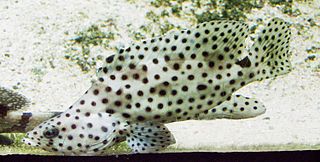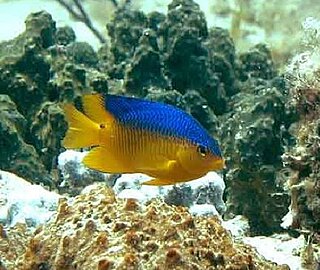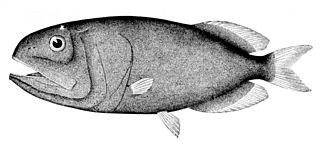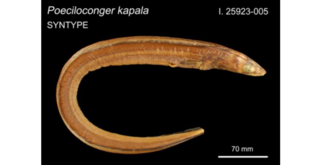
The Serranidae are a large family of fishes belonging to the order Perciformes. The family contains about 450 species in 65 genera, including the sea basses and the groupers. Although many species are small, in some cases less than 10 cm (3.9 in), the giant grouper is one of the largest bony fishes in the world, growing to 2.7 m in length and 400 kg (880 lb) in weight. Representatives of this group live in tropical and subtropical seas worldwide.

Pomacentridae is a family of ray-finned fish, comprising the damselfishes and clownfishes. This family were formerly placed in the order Perciformes but are now regarded as being incertae sedis in the subseries Ovalentaria in the clade Percomorpha. They are primarily marine, while a few species inhabit freshwater and brackish environments. They are noted for their hardy constitutions and territoriality. Many are brightly colored, so they are popular in aquaria.

Anomalopidae are a family of fish distinguished by bioluminescent organs located underneath their eyes, for which they are named. These light organs contain luminous bacteria and can be "shut off" by the fish using either a dark lid or by being drawn into a pouch. They are used to communicate, attract prey, and evade predators.

The Beryciformes are a poorly-understood order of carnivorous ray-finned fishes consisting of 7 families, 30 genera, and 161 species. They feed on small fish and invertebrates. Beyond this, little is known about the biology of most member species because of their nocturnal habits and deepwater habitats. All beryciform species are marine and most live in tropical to temperate, deepwater environments. Most live on the continental shelf and continental slope, with some species being found as deep as 2,000 m (6,600 ft). Some species move closer to the surface at night, while others live entirely in shallow water and are nocturnal, hiding in rock crevices and caves during the day. Several species are mesopelagic and bathypelagic. Beryciformes' bodies are deep and mildly compressed, typically with large eyes that help them see in darker waters. Colors range from red to yellow and brown to black, and sizes range from 8–61 cm (3.1–24.0 in). Member genera include the alfonsinos, squirrelfishes, flashlight fishes, fangtooth fishes, spinyfins, pineconefishes, redfishes, roughies, and slimeheads. A number of member species are caught commercially, including the alfonsino, the splendid alfonsino, and the orange roughy, the latter being much more economically important. Some species have bioluminescent bacteria contained in pockets of skin or in light organs near the eyes, including the anomalopids and monocentrids.
The Cetomimiformes or whalefishes are an order of small, deep-sea ray-finned fish. Some authorities include the whalefishes as part of the order Stephanoberyciformes, within the superfamily Cetomimoidea. Their sister order, the Beryciformes, includes the flashlight fish and squirrelfish.

Cetomimidae is a family of small, deep-sea cetomimiform fish. They are among the most deep-living fish known, with some species recorded at depths in excess of 3,500 m (11,500 ft). Females are known as flabby whalefishes, Males are known as bignose fishes, while juveniles are known as tapetails and were formerly thought to be in a separate family, dubbed Mirapinnidae. Adults exhibit extreme sexual dimorphism, and the adult males were once thought to be exemplars of still another family, Megalomycteridae.

The Atheriniformes, also known as the silversides, are an order of ray-finned fishes that includes the Old World silversides and several less-familiar families, including the unusual Phallostethidae. The order includes at least 354 species. They are found worldwide in tropical and temperate marine and freshwater environments.

Cardinalfishes are a family, Apogonidae, of ray-finned fishes found in the Atlantic, Indian, and Pacific Oceans; they are chiefly marine, but some species are found in brackish water and a few are found in fresh water. A handful of species are kept in the aquarium and are popular as small, peaceful, and colourful fish. The family includes about 370 species.
Collared wrigglers are perciform fishes in the family Xenisthmidae. They are native to the Indian and Pacific Oceans, where they are mostly reef-dwelling.
Gyrinomimus grahami is a flabby whalefish of the genus Gyrinomimus, found in all the southern oceans.

The redmouth whalefishes are two species of deep-sea whalefishes in the genus Rondeletia, the only genus in the family Rondeletiidae. They are apparently close to the velvet whalefish, and apparently also to the gibberfishes (Gibberichthyidae). The latter and the Rondeletiidae are the only known living fishes which have the mysterious Tominaga's organ.
Champion's tree mouse is a species of rodent in the family Muridae. It is found only in Papua New Guinea.

Dascyllus flavicaudus, common name yellowtail dascyllus, is a Damselfish belonging to the family Pomacentridae.

Xenisthmus is the most well-known genus in the family Xenisthmidae, which is regarded as a synonymous with the Eleotridae, a part of Gobiiformes. These small to very small fish are known as wrigglers, and live in reefs and among rubble in the Indo-Pacific.
Cetichthys is a genus of flabby whalefishes, which was first described in 1989 by John R. Paxton.
Danacetichthys galathenus is a species of flabby whalefish found in the ocean depths at around 1,330 metres (4,360 ft). This species grows to a length of 5.4 centimetres (2.1 in) SL.
Rhamphocetichthys savagei, Savage's bird-snouted whalefish, is a species of flabby whalefish found at depths of around 2,100 metres (6,900 ft). It is the only known member of its genus.

The fringefin trevally, also called fringe-finned trevally, round-finned trevally or reef herring, is a species of inshore marine fish classified in the jack and horse mackerel family Carangidae. A relatively small fish, the fringefin trevally is known to reach 40 cm (16 in), but is mostly encountered at lengths less than 25 cm (9.8 in). The fringefin trevally has an ovate body, with distinctive orange-yellow fins and a black opercular spot. The dental patterns of the species distinguish it from the closely related scads of the genus Alepes. Males have characteristic elongated dorsal and anal fins which produce a series of trailing filaments. The fringefin trevally is restricted to the waters of the Indo-Pacific, ranging from northern Australia to Papua New Guinea and eastern Indonesia. An inshore species, it is found in coastal and estuarine environments and exhibits daily and seasonal movements. The fringefin trevally is predatory, taking crustaceans as prey. The species is often taken as bycatch in prawn trawls and occasionally taken by anglers.

The headlight fish is a species of lanternfish in the family Myctophidae. It is also sometimes referred to as the headlight lanternfish, or even the lanternfish, though it is not the only species to be called this.

Ariosoma kapala is an eel in the family Congridae. It was first described in 1990 by Peter H. J. Castle as Poeciloconger kapala. The holotype was collected by the New South Wales Fisheries Research Vessel Kapala on April 11, 1985, during a bottom trawl at a depth of 46–64 m. The species was named for the FRV Kapala. In 1998, Shieh-Chieh Shen moved the species to the genus Ariosoma.













